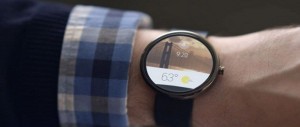Google announces Android Wear
Google announced Tuesday that it has developed a version of its Android mobile operating system specifically for wearable devices, doubling down on the early efforts in the space that it’s already made with its Google Glass headset. The tech giant debuted the new version of the system, Android Wear, in a blog post that explained that the firm is very excited about the future of wearable devices such as smart watches. Wearables “understand the context of the world around you, and you can interact with them simply and efficiently, with just a glance or a spoken word,” wrote Google senior vice president Sundar Pichai, who oversees the firm’s Android, Chrome and Apps division.
With Android Wear, Pichai said, Google will cover all types of wearables. But it will start with “the most familiar wearable,” watches. The watch software, Pichai said, will give consumers the tools to look things up more efficiently, search using their voices, monitor their health and fitness and control other devices such as their phone or television.
This is no pie-in-the-sky effort. LG has already announced a product that will run on the new system, the LG G Watch. Apart from a picture, LG hasn’t released much information on what the new watch will do. But it promises more details in the “coming months.”
“The opportunity to work with Google on LG G Watch was the perfect chance for LG to really pull out all stops in both design and engineering,” said Jong-seok Park, president and chief executive of LG Electronics Mobile Communications. “We’re confident that a well-designed device has the potential to take the smart wearable market by storm.”
Google’s announcement opens the floodgates for manufacturers to work with the company to build wearable devices with software that actually makes sense, rather than having to invest the time and energy on their own. By pushing a familiar platform like Android to wearable devices, one analyst said, Google makes it easy for the rosters of talented Android and Java developers to jump onto the new platform.
“This is one reason we saw Android apps increase at a rapid pace, and it is why we are likely to see the same happen with wearables,” said Al Hilwa, program director of software development research at IDC. “Allowing programmers to build such apps with some degree of expediency is what the Android [software developers kit] will be all about!”
It also means that time is tick, tick, ticking on for Apple to release its own version of a wearable device, a much-awaited and anticipated device that tech bloggers have nicknamed the “iWatch.” Apple hasn’t officially confirmed anything about a move into wearables, though Apple chief executive Tim Cook did say once that the firm finds wearables, and the wrist, “interesting.
While Apple is notorious for not wanting to release products until they’re perfect — even if it means coming into an industry late — Hilwa said that any announcement that could potentially expand the Android ecosystem this much should spur some movement in Cupertino. “I would expect this to matter a lot to Apple because, no matter their high-end, they are in an ecosystem battle with Android,” he said. “Apple can make a few amazing devices, and likely they will be big hits. But what Android Wear will stimulate is hundreds if not thousands of devices in addition to apps on top of them.”
Curious for more about what Google has in store for the wearables space? Here’s how the company itself frames that vision:
http://www.youtube.com/watch?feature=player_embedded&v=QrqZl2QIz0c




